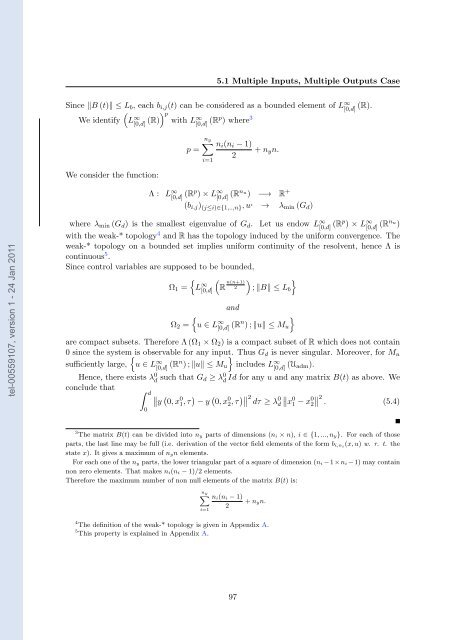Adaptative high-gain extended Kalman filter and applications
Adaptative high-gain extended Kalman filter and applications
Adaptative high-gain extended Kalman filter and applications
Create successful ePaper yourself
Turn your PDF publications into a flip-book with our unique Google optimized e-Paper software.
tel-00559107, version 1 - 24 Jan 2011<br />
5.1 Multiple Inputs, Multiple Outputs Case<br />
Since �B (t)� ≤Lb, each bi,j(t) can be considered as a bounded element of L∞ [0,d] (R).<br />
�<br />
We identify L∞ [0,d] (R)<br />
�p with L∞ [0,d] (Rp ) where3 We consider the function:<br />
p =<br />
ny �<br />
i=1<br />
ni(ni − 1)<br />
2<br />
+ nyn.<br />
Λ : L ∞ [0,d] (Rp ) × L ∞ [0,d] (Rnu ) −→ R +<br />
(bi,j) (j≤i)∈{1,..,n},u↩ → λmin (Gd)<br />
where λmin (Gd) is the smallest eigenvalue of Gd. Let us endow L ∞ [0,d] (Rp ) × L ∞ [0,d] (Rnu )<br />
with the weak-* topology4 <strong>and</strong> R has the topology induced by the uniform convergence. The<br />
weak-* topology on a bounded set implies uniform continuity of the resolvent, hence Λ is<br />
continuous5 .<br />
Since control variables are supposed to be bounded,<br />
Ω1 =<br />
�<br />
L ∞ [0,d]<br />
�<br />
R n(n+1)<br />
2<br />
�<br />
; �B� ≤Lb<br />
<strong>and</strong><br />
�<br />
Ω2 = u ∈ L ∞ [0,d] (Rn �<br />
);�u� ≤Mu<br />
are compact subsets. Therefore Λ (Ω1 × Ω2) is a compact subset of R which does not contain<br />
0 since the system is observable for any input. � Thus Gd is never singular. Moreover, for Mu<br />
sufficiently large,<br />
includes L∞ [0,d] (Uadm).<br />
�<br />
u ∈ L∞ [0,d] (Rn );�u� ≤Mu<br />
Hence, there exists λ0 d such that Gd ≥ λ0 d Id for any u <strong>and</strong> any matrix B(t) as above. We<br />
conclude that � d �<br />
�y � 0,x 0 1, τ � − y � 0,x 0 2, τ �� �2 dτ ≥ λ 0 �<br />
�x d<br />
0 1 − x 0 �<br />
�<br />
2<br />
2 . (5.4)<br />
0<br />
3 The matrix B(t) can be divided into ny parts of dimensions (ni × n), i ∈ {1, ..., ny}. For each of those<br />
parts, the last line may be full (i.e. derivation of the vector field elements of the form bi,n i (x, u) w. r. t. the<br />
state x). It gives a maximum of nyn elements.<br />
For each one of the ny parts, the lower triangular part of a square of dimension (ni −1×ni −1) may contain<br />
non zero elements. That makes ni(ni − 1)/2 elements.<br />
Therefore the maximum number of non null elements of the matrix B(t) is:<br />
ny �<br />
i=1<br />
ni(ni − 1)<br />
2<br />
+ nyn.<br />
4 The definition of the weak-* topology is given in Appendix A.<br />
5 This property is explained in Appendix A.<br />
97<br />
�

















